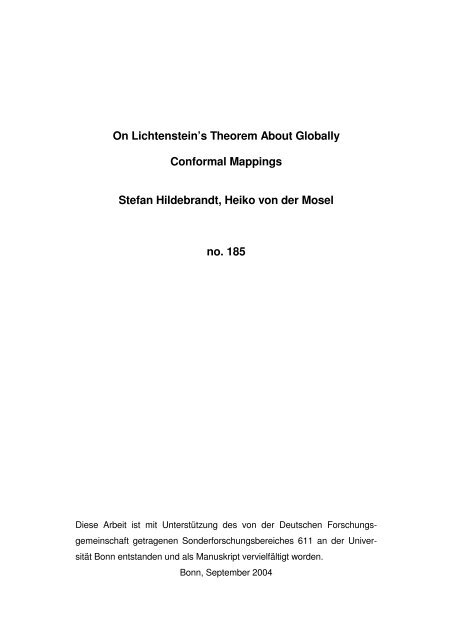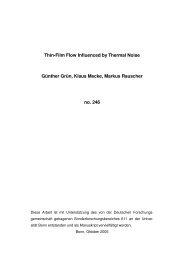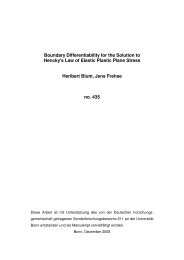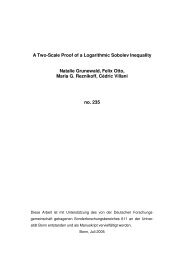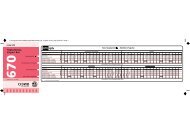On Lichtenstein's Theorem About Globally Conformal Mappings ...
On Lichtenstein's Theorem About Globally Conformal Mappings ...
On Lichtenstein's Theorem About Globally Conformal Mappings ...
Create successful ePaper yourself
Turn your PDF publications into a flip-book with our unique Google optimized e-Paper software.
<strong>On</strong> Lichtenstein’s <strong>Theorem</strong> <strong>About</strong> <strong>Globally</strong><br />
<strong>Conformal</strong> <strong>Mappings</strong><br />
Stefan Hildebrandt, Heiko von der Mosel<br />
no. 185<br />
Diese Arbeit ist mit Unterstützung des von der Deutschen Forschungs-<br />
gemeinschaft getragenen Sonderforschungsbereiches 611 an der Univer-<br />
sität Bonn entstanden und als Manuskript vervielfältigt worden.<br />
Bonn, September 2004
<strong>On</strong> Lichtenstein’s theorem about globally conformal<br />
mappings<br />
STEFAN HILDEBRANDT<br />
AND<br />
HEIKO VON DER MOSEL<br />
Mathematisches Institut der Universität Bonn<br />
September 1, 2004<br />
Abstract<br />
We present a new variational proof of the well-known fact that every<br />
Riemannian metric on a two-dimensional, simply connected domain<br />
with boundary can be represented by globally conformal parameters.<br />
From this the corresponding result for a metric on S 2 is derived.<br />
Mathematics Subject Classification (2000): 49Q05, 53A10, 53C42<br />
Gauß showed that any sufficiently small piece of a two-dimensional regular<br />
and real analytic surface X : B → R 3 can be mapped conformally onto a<br />
planar domain [6]. In 1916, Lichtenstein [13] proved that this is also possible<br />
if X is merely of class C 1,α instead of being real analytic. In conjunction with<br />
the uniformization theorem it follows that every regular C 1,α -surface can be<br />
transformed globally to conformal parameters. There are many proofs of<br />
different variants of this theorem; for references to the literature see e.g.<br />
Nitsche [17], §60. We begin by stating a global version of Lichtenstein’s<br />
theorem.<br />
To this end we consider a simply connected, bounded domain Ω in the<br />
two-dimensional Euclidean space R 2 with the norm |x| of its points x =<br />
(x 1 ,x 2 ).<br />
Assumption A(m, α). Suppose that Ω is bounded by a closed Jordan<br />
curve Γ of class C m,α , m ∈ N, α ∈ (0,1), and let (gjk(x)) be a positive<br />
definite, symmetric 2×2-matrix-valued function on Ω with gjk ∈ C m−1,α (Ω).<br />
1
2 S. HILDEBRANDT, H. VON DER MOSEL<br />
Extending (gjk) in a suitable way to all of R 2 we may assume without<br />
loss of generality that gjk ∈ C m−1,α (R 2 ), gjk = gkj,<br />
and<br />
(1)<br />
gjk(x) = δjk for |x| ≥ R0 ≫ 1,<br />
m1|ξ| 2 ≤ gjk(x)ξ j ξ k ≤ m2|ξ| 2 for x,ξ ∈ R 2<br />
with constants m1 and m2 satisfying 0 < m1 ≤ m2. Then<br />
(2)<br />
ds 2 := gjk(x)dx j dx k<br />
is a Riemannian metric on Ω which is extended to a metric on R 2 , in such<br />
a way that ds 2 coincides with the Euclidean metric<br />
ds 2 e := δjkdx j dx k<br />
outside the disk BR0 (0) ⊂ R2 .<br />
We consider mappings τ : B → R 2 from the unit disk<br />
B := {w = (u,v) ∈ R 2 : |w| < 1}<br />
into R 2 which we write as w ↦→ x = τ(w) = (τ 1 (w),τ 2 (w)). With any smooth<br />
map τ we associate real-valued functions E (τ)(w), F(τ)(w), G (τ)(w) of<br />
w = (u,v) ∈ B defined by<br />
E (τ) := gjk(τ)τ j u τk u , G (τ) := gjk(τ)τ j v τk v ,<br />
F(τ) := gjk(τ)τ j u τk v .<br />
If τ is merely of class H 1,2 (B, R 2 ), we still have E , F, G ∈ L 1 (B). The<br />
pull-back τ ∗ ds 2 of the metric (2) on R 2 to B takes the form<br />
τ ∗ ds 2 = E (τ)du 2 + 2F(τ)dudv + G (τ)dv 2 .<br />
If τ ∈ H 1,2 (B, R 2 ) satisfies the conformality relations<br />
(3)<br />
E (τ) = G (τ), F(τ) = 0,<br />
then τ is called a weakly conformal mapping (of B onto τ(B)). A conformal<br />
mapping τ from B onto Ω (or from B onto Ω) is a diffeomorphism from B<br />
onto Ω (or from B onto Ω, respectively) satisfying (3). For such a mapping<br />
we have λ := E (τ) = G (τ) > 0 on B (or B resp.) and τ ∗ds2 = λ · ds2 e , that<br />
is,<br />
τ ∗ ds 2 = λ(u,v) · (du 2 + dv 2 ), λ > 0.<br />
Then we have the following global form of Lichtenstein’s result which can<br />
be viewed as a generalized version of Riemann’s mapping theorem:
CONFORMAL MAPPINGS 3<br />
<strong>Theorem</strong> 1. Let the assumption A(m,α) be satisfied for some m ∈ N and<br />
α ∈ (0,1). Then there is a conformal mapping τ from B onto Ω which is of<br />
class C m,α (B, R 2 ).<br />
Recently, F. Sauvigny [18], [19] provided an elegant proof of this result (for<br />
m = 2) using a continuity method. C.B. Morrey outlined a variational proof<br />
which, however, is not complete (cf. [16], Section 9.3). In 1984, J. Jost gave<br />
a variational proof by minimizing Dirichlet’s integral<br />
D(τ) := 1<br />
2<br />
�<br />
B<br />
[E (τ) + G (τ)]dudv<br />
in the weak H1,2-closure of all diffeomorphisms τ from B to Ω thereby<br />
rectifying Morrey’s approach (cf. [11] and also [12], Chapter 3). Here,<br />
following some ideas of [10], we want to give a new variational proof by<br />
minimizing the area functional<br />
�<br />
�<br />
A(τ) := E (τ)G (τ) − F(τ) 2 dudv<br />
B<br />
in the class C(Γ) of mappings τ ∈ H 1,2 (B, R 2 ) bounded by Γ “in the<br />
sense of Plateau”. Precisely speaking, C(Γ) consists of those mappings<br />
τ ∈ H 1,2 (B, R 2 ) whose Sobolev trace τ|∂B is a continuous, weakly monotonic<br />
map of ∂B onto Γ which is of degree one (i.e. τ(w) traverses once the<br />
Jordan curve Γ if w circles once around ∂B).<br />
We have the following result which implies <strong>Theorem</strong> 1:<br />
<strong>Theorem</strong> 2. If assumption A(m,α) holds for some m ∈ N and α ∈ (0,1),<br />
then there is a minimizer τ of A in C(Γ) satisfying<br />
A(τ) = inf C(Γ) A = inf C(Γ) D = D(τ).<br />
This minimizer provides a conformal mapping from B onto Ω and is of class<br />
C m,α (B, R 2 ).<br />
In other words, a conformal mapping from (B,ds 2 e) onto (Ω,ds 2 ) is obtained<br />
by solving Plateau’s problem for the contour Γ in the Riemannian manifold<br />
(R 2 ,ds 2 ). We note that already J. Douglas had proposed a proof of the classical<br />
Riemann mapping theorem in the complex plane by solving Plateau’s<br />
problem in the Euclidean plane (R 2 ,ds 2 e), thereby obtaining as well a proof<br />
of the Osgood-Carathéodory extension of Riemann’s theorem (see [4]). Douglas’s<br />
method approaches the conformal mapping problem in a way opposite<br />
to the standard proof where one first maps B conformally onto Ω (or rather
4 S. HILDEBRANDT, H. VON DER MOSEL<br />
Ω onto B) and then extends this mapping to a homeomorphism from B onto<br />
Ω = Ω ∪ Γ, which is a diffeomorphism if Γ is smooth.<br />
A well-known consequence of <strong>Theorem</strong> 1 is that to any immersed surface<br />
X : B → R n , n ≥ 2, of class C m,α there exists an equivalent representation<br />
Y = X ◦ τ which is conformally parametrized, i.e. with |Yu| 2 = |Yv| 2 and<br />
Yu · Yv = 0.<br />
Proof of <strong>Theorem</strong> 2. (i) We begin by considering the modified minimum<br />
problem<br />
A ǫ (τ) −→ min for τ ∈ C(Γ),<br />
where A ǫ is defined as<br />
A ǫ (τ) := (1 − ǫ)A(τ) + ǫD(τ) for 0 ≤ ǫ ≤ 1<br />
and τ ∈ H 1,2 (B, R 2 ). Both A and D, and therefore also A ǫ , are sequentially<br />
lower semicontinuous in H 1,2 (B, R 2 ) according to the semicontinuity theorem<br />
by Acerbi and Fusco [1], which is applicable here since A can also be<br />
written in the form<br />
�<br />
A(τ) =<br />
B<br />
� g(τ) |det Dτ|dudv,<br />
where Dτ is the Jacobian matrix of τ and g(τ) := det(gjk(τ)).<br />
Fix some ǫ with 0 < ǫ ≤ 1 and choose a sequence of mappings τj ∈ C(Γ)<br />
with<br />
A ǫ (τj) → d(ǫ) := inf C(Γ) A ǫ .<br />
Since A ǫ is conformally invariant we can assume that the sequence {τj}<br />
satisfies a three-point condition<br />
τj(wk) = pk, k = 1,2,3,<br />
with three distinct points w1,w2,w3, and p1,p2,p3, on ∂B and Γ, respectively.<br />
Passing to an appropriate subsequence, again denoted by {τj}, we<br />
obtain<br />
τj ⇀ τ ǫ in H 1,2 (B, R 2 ) and τj|∂B → τ ǫ |∂B in C 0 (∂B, R 2 ) as j → ∞<br />
for some τ ǫ ∈ C(Γ); see e.g. [3], vol. I, Section 4.3. It follows from the lower<br />
semicontinuity of A ǫ that<br />
d(ǫ) ≤ A ǫ (τ ǫ ) ≤ lim<br />
j→∞ A ǫ (τj) = d(ǫ),
whence<br />
CONFORMAL MAPPINGS 5<br />
A ǫ (τ ǫ ) = d(ǫ) = inf C(Γ) A ǫ ,<br />
and so τ ǫ minimizes A ǫ in C(Γ). Since A is parameter invariant, the inner<br />
variation ∂A(τ ǫ ,η) vanishes for any vector field η ∈ C 1 (B, R 2 ). Hence the<br />
minimum property of τ ǫ implies ∂D(τ ǫ ,η) = 0 for any η ∈ C 1 (B, R 2 ) such<br />
that η|∂B is tangential to ∂B.<br />
Set a := E(τ ǫ ) − G(τ ǫ ), b := 2F(τ ǫ ), and φ := a − ib. Then we have in<br />
particular �<br />
[a(η<br />
B<br />
1 u − η2 v ) + b(η2 u + η1 v )]dudv = 0<br />
for any η = (η 1 ,η 2 ) ∈ C ∞ c (B, R 2 ). Let η = Sδµ where µ = (µ 1 ,µ 2 ) ∈<br />
C ∞ c (B, R 2 ) and Sδ is a smoothing operator with a symmetric kernel kδ,<br />
0 < δ ≪ 1, i.e., Sδµ = kδ ∗ µ. Then<br />
�<br />
B<br />
[a δ (µ 1 u − µ2v ) + bδ (µ 2 u + µ1v )]dudv = 0<br />
for a δ := Sδa, b δ := Sδb. An integration by parts yields<br />
�<br />
[−(a<br />
B<br />
δ u + bδv )µ1 + (a δ v − bδu )µ2 ]dudv = 0<br />
for any µ ∈ C ∞ c (B ′ , R 2 ) with B ′ ⊂⊂ B and 0 < δ < δ0(B ′ ). Therefore the<br />
functions a δ ,b δ ∈ C ∞ (B ′ ) satisfy the Cauchy-Riemann-equations a δ u = −bδ v ,<br />
a δ v = −(−bδ u ) in B′ , and so φ δ := a δ − ib δ is holomorphic in B ′ ⊂⊂ B for<br />
0 < δ < δ0(B ′ ). Since φ δ → φ in L 1 (B ′ ) for any B ′ ⊂⊂ B as δ → 0 we infer<br />
that φ = a − ib is holomorphic in B. Now we can apply a reasoning due to<br />
Courant [2] and obtain φ = 0, that is,<br />
(4)<br />
E (τ ǫ ) = G (τ ǫ ), F(τ ǫ ) = 0;<br />
see e.g. [3], vol. I, pp. 249–251.<br />
By Lagrange’s identity we have A(τ) ≤ D(τ) for any τ ∈ H 1,2 (B, R 2 ),<br />
and A(τ) = D(τ) holds if and only if τ satisfies (3), i.e. [E (τ) − G (τ) −<br />
2iF(τ)](w) = 0 a.e. on B. Thus,<br />
(5)<br />
d(ǫ) = A ǫ (τ ǫ ) = A(τ ǫ ) = D(τ ǫ ) for 0 < ǫ ≤ 1,<br />
and for any τ ∈ C(Γ) we have<br />
A ǫ (τ ǫ ) ≤ A ǫ (τ) = (1 − ǫ)A(τ) + ǫD(τ) ≤ D(τ).
6 S. HILDEBRANDT, H. VON DER MOSEL<br />
In conjunction with (5) we arrive at<br />
whence<br />
(6)<br />
D(τ ǫ1 ) ≤ D(τ ǫ2 ) for all ǫ1,ǫ2 ∈ (0,1]<br />
D(τ ǫ ) = A(τ ǫ ) = A ǫ (τ ǫ ) ≡ const =: c0 for 0 < ǫ ≤ 1.<br />
<strong>On</strong> account of τ ǫ ∈ C(Γ) and of (6) we infer from Poincaré’s inequality that<br />
there is a constant c > 0 such that<br />
�τ ǫ � H 1,2 (B,R 2 ) ≤ c for 0 < ǫ ≤ 1.<br />
Moreover, we have τ ǫ (wk) = pk for any ǫ ∈ (0,1] and k = 1,2,3. Then the<br />
same reasoning as above yields the existence of a sequence of numbers ǫj > 0<br />
with ǫj → 0 and of a mapping τ ∈ C(Γ) such that τ ǫj ⇀ τ in H 1,2 (B, R 2 ),<br />
whence<br />
d(0) ≤ A(τ) ≤ lim inf<br />
j→∞ A(τǫj ) = lim inf<br />
j→∞ Aǫj (τ ǫj )<br />
≤ lim<br />
j→∞ A ǫj (τ ∗ ) = A(τ ∗ )<br />
for any τ ∗ ∈ C(Γ). Since d(0) = inf C(Γ) A we obtain A(τ) = d(0), i.e., τ<br />
minimizes A in C(Γ).<br />
By (6) we obtain c0 = A ǫ (τ ǫ ) ≤ A ǫ (τ) → A(τ) ≤ D(τ) as ǫ → +0, and<br />
the weak semicontinuity of D in H 1,2 (B, R 2 ) yields in conjunction with (6)<br />
D(τ) ≤ lim<br />
j→∞ D(τ ǫj ) = c0.<br />
Thus we arrive at A(τ) = D(τ) = c0. The first equation yields the conformality<br />
relations (3), whereas the second one implies D(τ ǫj ) = D(τ), whence<br />
τ ǫj → τ in H 1,2 (B, R 2 ). In conjunction with (4) this provides another proof<br />
of (3).<br />
From A ≤ D we infer<br />
and so it follows that<br />
D(τ) = A(τ) = d(0) = inf C(Γ) A ≤ inf C(Γ) D ≤ D(τ),<br />
A(τ) = inf C(Γ) A = inf C(Γ) D = D(τ)<br />
as we have claimed. Thus τ minimizes D in C(Γ). Since (1) implies<br />
�<br />
m1 |∇σ| 2 �<br />
dudv ≤ 2D(σ) ≤ m2 |∇σ| 2 dudv<br />
B<br />
B
CONFORMAL MAPPINGS 7<br />
for any σ ∈ H 1,2 (B, R 2 ), a well-known reasoning due to Morrey (see e.g.<br />
[16]) yields τ ∈ C 0 (B, R 2 ) ∩ C 0,β (B, R 2 ) with β := m1/m2 if one takes also<br />
E (τ) = G (τ) into account. (Let us point out that so far we have only used<br />
that Γ is rectifiable, and that gjk = gkj are continuous on R 2 and satisfy<br />
(1).)<br />
(ii) By a topological argument we infer<br />
(7)<br />
Ω ⊂ τ(B)<br />
from τ ∈ C 0 (B, R 2 ), the monotonicity of τ|∂B, and the fact that τ(∂B) =<br />
Γ = ∂Ω.<br />
As Γ is of class C 1 , there is a C 1 -diffeomorphism τ0 of class C(Γ) from<br />
B onto Ω. Since τ minimizes A in C(Γ) we obtain A(τ) ≤ A(τ0), and the<br />
transformation formula yields<br />
�<br />
A(τ0) =<br />
Thus we have<br />
(8)<br />
Ω<br />
�<br />
A(τ) ≤ A(τ0) =<br />
� g(x) dx 1 dx 2 .<br />
Ω<br />
� g(x) dx 1 dx 2 .<br />
In addition, if τ ∈ C 0,1 (B, R 2 ) the area formula [5, <strong>Theorem</strong> 3.2.3 (2)] yields<br />
in our special case<br />
(9)<br />
where<br />
�<br />
A(τ) =<br />
R 2<br />
Θ(τ,x) � g(x) dx 1 dx 2 ,<br />
Θ(τ,x) := ♯{w ∈ B : τ(w) = x}<br />
is the “number of solutions” w ∈ B to the equation τ(w) = x. (In fact,<br />
formula (9) can even be verified if τ ∈ C 0,β (B, R 2 ) ∩ H 1,2 (B, R 2 ) for some<br />
β ∈ (0,1); see [8, Remark 4, p. 231] in connection with [14, <strong>Theorem</strong> C].<br />
Therefore (9) follows already from gjk ∈ C 0 (R 2 ) and (1).)<br />
From (7) we infer that Θ(τ,x) ≥ 1 if x ∈ Ω, and so by (9):<br />
�<br />
�<br />
1 2<br />
A(τ) ≥ g(x) dx dx .<br />
<strong>On</strong> account of (8) we arrive at<br />
(10)<br />
�<br />
A(τ) = A(τ0) =<br />
�<br />
�<br />
1 2<br />
g(x) dx dx =<br />
Ω<br />
Ω<br />
Ω<br />
� g(x) dx 1 dx 2 ,
8 S. HILDEBRANDT, H. VON DER MOSEL<br />
since the Lebesgue measure L2 (Γ) of the Jordan curve Γ = ∂Ω is zero. By<br />
(7), (9), and (10) we finally obtain<br />
�<br />
1 for L<br />
Θ(τ,x) =<br />
2− a.e. x ∈ Ω<br />
(11)<br />
0 for L 2 − a.e. x ∈ R 2 \ Ω.<br />
(iii) Next we mention the well-known fact that, because of (3), the mapping<br />
(u,v) ↦→ (τ 1 (u,v),τ 2 (u,v)) satisfies the generalized Cauchy-Riemann<br />
system<br />
� g(τ) τ 1 v = −ρ[g12(τ)τ 1 u + g22(τ)τ 2 u ]<br />
(12)<br />
� g(τ) τ 2 v = ρ[g11(τ)τ 1 u + g12(τ)τ 2 u ]<br />
a.e. on B, where ρ(u,v) = ±1. In fact, the equation F(τ) = 0 can be written<br />
as<br />
= 0,<br />
[g11(τ)τ 1 u + g12(τ)τ 2 u ]τ1 v + [g12(τ)τ 1 u + g22(τ)τ 2 u ]τ2 v<br />
which implies (12) with some factor ρ, and then the identity E (τ) = G (τ)<br />
implies ρ(u,v) = ±1. Note that (12) holds also at points where τ 1 v = τ 2 v = 0<br />
because there we have ∇τ = 0 due to the conformality relations (3).<br />
From (12) we infer the equation<br />
� g(τ) detDτ = ρE (τ).<br />
(13)<br />
Therefore det Dτ(w) = 0 if and only if Dτ(w) = 0.<br />
We note again that (3) and therefore also (12) and (13), follow already<br />
from the assumption that gjk ∈ C 0 (B) satisfies (1) and that Γ is rectifiable.<br />
(iv) Now we assume Γ ∈ C m,α and gjk ∈ C m−1,α with m ≥ 2, α ∈<br />
(0,1). Since τ minimizes Dirichlet’s integral in C(Γ), well-known regularity<br />
theorems yield τ ∈ C m,α (B, R 2 ) as well as an asymptotic expansion<br />
(14)<br />
τw = a(w − w0) ν + o(|w − w0| ν ) as w → w0<br />
with a ∈ C 2 \ {0} and ν ∈ N at any branch point w0 of τ, i.e., at any zero<br />
w0 = u0+iv0 ∈ B of the Wirtinger derivative τw = (1/2)(τu −iτv) : B → C 2 ,<br />
where w = u+iv, and B in R 2 is identified with the corresponding complex<br />
disk in C ; see Morrey [16], Tomi [21], and Heinz-Hildebrandt [9]. Clearly,<br />
gjk(x0)a j a k = 0 for x0 = τ(w0) and a = (a 1 ,a 2 ). Integrating (14) we obtain<br />
for any branch point w0 ∈ B of τ and for 0 < |x − τ(w0)| ≪ 1 that<br />
(15)<br />
(16)<br />
Θ(τ,x) ≥ 2 if w0 ∈ B,<br />
Θ(τ,x) ≥ 1 if w0 ∈ ∂B.
CONFORMAL MAPPINGS 9<br />
From (11), (15), and (16) we infer that τ has no branch points in B, and<br />
that<br />
�<br />
Θ(τ,x) =<br />
1<br />
0<br />
for x ∈ Ω,<br />
for x ∈ R2 \ Ω.<br />
Thus τ furnishes a C m,α -diffeomorphism from B onto Ω satisfying the generalized<br />
Cauchy-Riemann equations (12) with either ρ(w) ≡ 1 on B or<br />
ρ(w) ≡ −1 on B by (13). In the first case we have det Dτ > 0 on B,<br />
and det Dτ < 0 on B in the second. (In the classical notation this means<br />
that τ is either strictly conformal, or else strictly anti-conformal.)<br />
We also note that τ is uniquely determined if we additionally impose a<br />
three point condition τ(wk) = pk, k = 1,2,3, with three points wk on ∂B<br />
and pk on Γ, respectively.<br />
(v) Finally, if we merely assume Γ ∈ C 1,α and gjk ∈ C 0,α , then τ turns<br />
out to be a C1,α-diffeomorphism from B onto Ω. This follows from (iv),<br />
approximating Γ and gjk by C∞-curves Γn and C∞-coefficients gn jk , applying<br />
a priori estimates for the corresponding mappings τn : B → Ω and their<br />
inverses τ −1<br />
n which satisfy equations similar to (12). We leave the details to<br />
the reader (cf. e.g. Schulz [20], Chapter 6, Jost [12], Chapter 3, or Morrey<br />
[16], pp. 373–374).<br />
Similarly, if Γ is merely a closed Jordan curve it follows that τ is a<br />
homeomorphism from B onto Ω and a C m,α -diffeomorphism from B onto Ω<br />
provided that the coefficients gjk are assumed to be of class C m,α , m ≥ 1,<br />
α ∈ (0,1). ✷<br />
<strong>On</strong>e can use <strong>Theorem</strong> 2 to prove a version of Lichtenstein’s theorem for<br />
two-dimensional Riemannian manifolds M homeomorphic to the standard<br />
) be the standard sphere carrying<br />
sphere S2 ⊂ R3 . In fact, let S := (S2 ,ds2 e<br />
the metric ds2 e induced by the ambient Euclidean space R3 , and let M :=<br />
(S2 ,ds2 ) be S2 equipped with an arbitrary Riemannian metric ds2 of class<br />
Cm,α , m ∈ N, α ∈ (0,1). By d(P,Q) we denote the distance of any two<br />
points P,Q ∈ S2 with respect to the standard metric ds2 e . For 0 < r < π we<br />
set<br />
Br(P) := {Q ∈ S 2 : d(P,Q) < r}, Ωr(P) := S 2 \ Br(P)<br />
Cr(P) := ∂Br(P) = {Q ∈ S 2 : d(P,Q) = r} = ∂Ωr(P).<br />
Finally we choose two antipodal points N and S on S 2 which are called<br />
north pole and south pole of S 2 respectively.
10 S. HILDEBRANDT, H. VON DER MOSEL<br />
<strong>Theorem</strong> 3. There is a conformal diffeomorphism τ from S onto M of<br />
class C m,α ; the conformal mapping τ minimizes both the area A and the<br />
Dirichlet integral D among all maps σ ∈ H 1,2 (S, M).<br />
Sketch of the proof. For n ∈ N we set Sn := (Ω 1/n(N),ds 2 e ) and Mn :=<br />
(Ω 1/n(N),ds 2 ). By <strong>Theorem</strong> 2 there is a conformal diffeomorphism τn from<br />
Sn onto Mn. We may assume that τn(S) = S since, for any disk D in C,<br />
and for any point P ∈ D, there is a conformal mapping from D onto itself<br />
which maps P into the origin of D. Furthermore,<br />
D(τn) = A(τn) ≤ area of M for n ∈ N .<br />
Then, by the Courant-Lebesgue lemma (see e.g. [3], [12], or [16]), for n ≫ 1<br />
and Ω ′ ⊂⊂ Ω1/n(N) the mappings τn are equicontinuous on Ω ′ , since the τn<br />
are homeomorphisms, and similarly their inverses σn := τ −1<br />
n are equicontinuous<br />
on Ω ′′ ⊂⊂ Ω1/n(N) for n ≫ 1. Thus there are mappings τ ∈ C0 (S ′ , M ′ )<br />
and σ ∈ C0 (M ′ , S ′ ) with S ′ := S \ {N}, M ′ := M \ {N}, such that τn and<br />
σn converge uniformly to τ and σ respectively on each ball Br(S) with<br />
0 < r < π. Furthermore, the Courant-Lebesgue lemma yields for 0 < δ < 1<br />
and n > 1/δ :<br />
M-length of τn(Cδ(N)) ≤ λ(δ)<br />
and<br />
S-length of σn(Cδ(N)) ≤ λ(δ)<br />
with λ(δ) → 0 as δ → +0. Since τn and σn = τ −1<br />
n are diffeomorphisms we<br />
infer from τn(S) = S = σn(S), the uniform boundedness of the areas (and<br />
therefore of the Dirichlet integrals) of σn and τn, and the Courant-Lebesgue<br />
lemma, that the curves τn(Cδ(N)) and σn(Cδ(N)) “shrink” to the north<br />
pole N as δ → 0 and n → ∞, and not to the south pole S.<br />
Then we conclude that, for any ǫ ∈ (0,1), there is a δ ∈ (0,1) such that<br />
τn(Sn ∩ Bδ(N)) ⊂ Bǫ(N) and σn(Mn ∩ Bδ(N)) ⊂ Bǫ(N) for all n > 1/δ<br />
whence<br />
τ(S ′ ∩ Bδ(N)) ⊂ Bǫ(N) and σ(M ′ ∩ Bδ(N)) ⊂ Bǫ(N).<br />
Setting τ(N) := N and σ(N) := N we obtain τ ∈ C 0 (S, M) and σ ∈<br />
C 0 (M, S) as well as σ ◦ τ = id S and τ ◦ σ = id M recalling that σn = τ −1<br />
n .<br />
Thus τ is a homeomorphism from S onto M. It follows that<br />
(17)<br />
Θ(τ,P) = 1 for all P ∈ M.
CONFORMAL MAPPINGS 11<br />
Let m ≥ 2. Then �τn� C 2,α (Ω ′ ) ≤ const. =: c(Ω ′ ) for every Ω ′ ⊂⊂ S ′ and<br />
n > n0(Ω ′ ), and consequently<br />
�τ − τn� C 2 (Ω ′ ,M) → 0 as n → ∞ for Ω ′ ⊂⊂ S ′ .<br />
Thus τ is both harmonic and weakly conformal on S ′ . Since τ is continuous<br />
on S, the singularity at N is removable, and so τ is harmonic and conformal<br />
on S. <strong>On</strong> account of (17), τ cannot have any branch points on S, and so τ<br />
is a diffeomorphism (cf. (13)). Since the metric of M is of class C m,α , we<br />
finally conclude that τ ∈ C m,α (S, M).<br />
The case m = 1 can be treated by approximation. ✷<br />
Acknowledgements. We are grateful to Prof. Klaus Steffen for stimulating<br />
discussions. Moreover we should like to thank the colleagues from<br />
the Bernoulli Centre at the EPFL in Lausanne and in particular Prof. John<br />
Maddocks for their hospitality in Spring 2004.<br />
References<br />
[1] E. Acerbi; N. Fusco, Semicontinuity problems in the calculus of variations. Arch.<br />
Rat. Mech. Anal. 86 (1984), 125–145.<br />
[2] R. Courant, Dirichlet’s principle, conformal mapping, and minimal surfaces. Interscience<br />
Publ. New York 1950.<br />
[3] U. Dierkes; S. Hildebrandt; A. Küster; O. Wohlrab, Minimal Surfaces, vols I & II.<br />
Grundlehren der math. Wissenschaften 295 & 296, Springer, Berlin 1992.<br />
[4] J. Douglas, Solution of the problem of Plateau. Trans. Amer. Math. Soc. 33 (1931),<br />
263–321.<br />
[5] H. Federer, Geometric Measure Theory. Grundlehren der math. Wissenschaften 153,<br />
Springer, Berlin 1969.<br />
[6] C.F. Gauß, Allgemeine Auflösung der Aufgabe: die Theile einer gegebnen Fläche auf<br />
einer andern gegebnen Fläche so abzubilden, dass die Abbildung dem Abgebildeten<br />
in den kleinsten Theilen ähnlich wird. Als Beantwortung der von der königlichen<br />
Societät der Wissenschaften in Copenhagen für 1822 aufgegebnen Preisfrage. Schumachers<br />
Astronomische Abhandlungen, Drittes Heft, 1–30, Altona 1825. (Cf. also:<br />
Werke Bd. IV, 189–216.)<br />
[7] M. Giaquinta; M. Modica; J. Souček, Cartesian Currents in the Calculus of Variations.<br />
Ergebnisse der Mathematik und ihrer Grenzgebiete, 3. Folge, vol. 37, Springer,<br />
Berlin 1998.<br />
[8] P. Hajlasz, Sobolev mappings, co-area formula and related topics. In: Proceedings<br />
of Analysis and Geometry, pp. 227–254. Novosibirsk, Sobolev Inst. Press, 2000.
12 S. HILDEBRANDT, H. VON DER MOSEL<br />
[9] E. Heinz; S. Hildebrandt, Some remarks on minimal surfaces in Riemannian manifolds.<br />
Comm. Pure. Appl. Math. 23 (1970), 371–377.<br />
[10] S. Hildebrandt; H. von der Mosel, <strong>On</strong> two-dimensional parametric variational problems.<br />
Calc. Var. 9 (1999), 249–267.<br />
[11] J. Jost, <strong>Conformal</strong> mappings and the Plateau-Douglas problem in Riemannian manifolds.<br />
J. reine angew. Math. 359 (1985), 37–54.<br />
[12] J. Jost, Two-dimensional Geometric Variational Problems. Wiley, New York 1990.<br />
[13] L. Lichtenstein, Zur Theorie der konformen Abbildung: Konforme Abbildung nichtanalytischer,<br />
singularitätenfreier Flächenstücke auf ebene Gebiete. Bull. Acad. Sci.<br />
Cracovie, Cl. Sci. Math. Nat. Ser. A (1916), 192–217.<br />
[14] J. Mal´y; O. Martio, Lusin’s condition (N) and mappings of the class W 1,n . J. reine<br />
angew. Math. 458 (1995), 19–36.<br />
[15] C.B. Morrey, The problem of Plateau on a Riemannian manifold. Ann. Math. 49<br />
(1948), 807–851.<br />
[16] C.B. Morrey, Multiple integrals in the calculus of variations. Grundlehren der math.<br />
Wissenschaften 130, Springer, Berlin 1966.<br />
[17] J.C.C. Nitsche, Vorlesungen über Minimalflächen. Grundlehren der math. Wissenschaften<br />
199, Springer, Berlin 1976.<br />
[18] F. Sauvigny, Introduction of isothermal parameters into a Riemannian metric by the<br />
continuity method. Analysis 19 (1999), 235–243.<br />
[19] F. Sauvigny, Global C 2+α -estimates for conformal maps. In: Geometric Analysis<br />
and Nonlinear Partial Differential Equations (S. Hildebrandt & H. Karcher eds.),<br />
pp. 105–115. Springer, Berlin 2003.<br />
[20] F. Schulz, Regularity theory for quasilinear elliptic systems and Monge-Ampère equations<br />
in two dimensions. Springer Lecture Notes 1445, Springer Berlin 1990.<br />
[21] F. Tomi, Ein einfacher Beweis eines Regularitätssatzes für schwache Lösungen<br />
gewisser elliptischer Systeme. Math. Z. 112 (1969), 214–218.<br />
Stefan Hildebrandt<br />
Mathematisches Institut<br />
Universität Bonn<br />
Beringstraße 1<br />
D-53115 Bonn<br />
GERMANY<br />
Heiko von der Mosel<br />
Mathematisches Institut<br />
Universität Bonn<br />
Beringstraße 1<br />
D-53115 Bonn<br />
GERMANY<br />
E-mail: heiko@<br />
math.uni-bonn.de
Bestellungen nimmt entgegen:<br />
Institut für Angewandte Mathematik<br />
der Universität Bonn<br />
Sonderforschungsbereich 611<br />
Wegelerstr. 6<br />
D - 53115 Bonn<br />
Telefon: 0228/73 3411<br />
Telefax: 0228/73 7864<br />
E-mail: anke@iam.uni-bonn.de Homepage: http://www.iam.uni-bonn.de/sfb611/<br />
Verzeichnis der erschienenen Preprints ab No. 160<br />
160. Giacomelli, Lorenzo; Knüpfer, Hans; Otto, Felix: Maximal Regularity for a Degenerate<br />
Operator for Fourth Order<br />
161. Drwenski, Jörg; Otto, Felix: ℋ 2 -Matrix Method vs. FFT in Thin-Film Stray-Field<br />
Computations<br />
162. Otto, Felix; Westdickenberg, Michael: Convergence of Thin Film Approximation for a Scalar<br />
Conservation Law<br />
163. Kunoth, Angela, Sahner, Jan: Wavelets on Manifolds: An Optimized Construction<br />
164. Albeverio, Sergio; Hryniv, Rostyslav; Mykytyuk, Yaroslav: Inverse Spectral Problems for<br />
Sturm-Liouville Operators in Impedance Form<br />
165. Albeverio, Sergio; Koshmanenko, Volodymir; Kuzhel, Sergii: <strong>On</strong> a Variant of Abstract<br />
Scattering Theory in Terms of Quadratic Forms<br />
166. Albeverio, Sergio; Brasche, Johannes F.; Malamud, Mark; Neidhardt, Hagen: Inverse<br />
Spectral Theory for Symmetric Operators with Several Gaps: Scalar-Type Weyl<br />
Functions<br />
167. Schätzle, Reiner: Lower Semicontinuity of the Willmore Functional for Currents<br />
168. Ebmeyer, Carsten; Urbano, José Miguel: The Smoothing Property for a Class of Doubly<br />
Nonlinear Parabolic Equations; erscheint in: Trans. Am. Math. Soc.<br />
169. Albeverio, Sergio; Lakaev, Saidakhmat N.; Djumanova, Ramiza Kh.: <strong>On</strong> the Essential and<br />
Discrete Spectrum of a Model Operator<br />
170. Albeverio, Sergio; Lakaev, Saidakhmat N.; Abdullaev, Janikul I.: <strong>On</strong> the Spectral Properties<br />
of Two-Particle Discrete Schrödinger Operators<br />
171. Albeverio, Sergio; Lakaev, Saidakhmat N.; Makarov, K.A.; Muminov, Z.I.: Low-Energy<br />
Effects for the Two-Particle Operators on a Lattice<br />
172. Castaño, Daniel; Kunoth, Angela: Robust Progression of Scattered Data with Adaptive<br />
Spline-Wavelets<br />
173. Djah, Sidi Hamidou; Gottschalk, Hanno; Ouerdiane, Habib: Feynman Graphs for non-<br />
Gaussian Measures
174. Djah, Sidi Hamidou; Gottschalk, Hanno; Ouerdiane, Habib: Feynman Graph Representation<br />
of the Perturbation Series for General Functional Measures<br />
175. not published<br />
176. Albeverio, Sergio; Shelkovich, Vladimir M.: Delta-Shock Waves in Multidimensional Non-<br />
Conservative System of Zero-Pressure Gas Dynamics<br />
177. Albeverio, Sergio; Kuzhel, Sergej: η-Hermitian Operators and Previously Unnoticed<br />
Symmetries in the Theory of Singular Perturbations<br />
178. Albeverio, Sergio; Alimov, Shavkat: <strong>On</strong> Some Integral Equations in Hilbert Space with an<br />
Application to the Theory of Elasticity; eingereicht bei: Oper. Th. and Int. Eqts.<br />
179. Albeverio, Sergio; Galperin, Gregory; Nizhnik, Irena L.; Nizhnik, Leonid P.: Generalized<br />
Billiards Inside an Infinite Strip with Periodic Laws of Reflection Along the Strip’s<br />
Boundaries; eingereicht bei: Regular and Chaotic Dynamics<br />
180. Albeverio, Sergio; Torbin, Grygoriy: Fractal Properties of Singular Probability Distributions<br />
with Independent Q*-Digits; eingereicht bei: Bull. Sci. Math.<br />
181. Melikyan, Arik; Botkin, Nikolai; Turova, Varvara: Propagation of Disturbances in Inhomogeneous<br />
Anisotropic Media<br />
182. Albeverio, Sergio; Bodnarchuk, Maksim; Koshmanenko, Volodymyr: Dynamics of Discrete<br />
Conflict Interactions between Non-Annihilating Opponents<br />
183. Albeverio, Sergio; Daletskii, Alexei: L 2 -Betti Numbers of Infinite Configuration Spaces<br />
184. Albeverio, Sergio; Daletskii, Alexei: Recent Developments on Harmonic Forms and L 2 -Betti<br />
Numbers of Infinite Configuration Spaces with Poisson Measures<br />
185. Hildebrandt, Stefan; von der Mosel, Heiko: <strong>On</strong> Lichtenstein’s <strong>Theorem</strong> <strong>About</strong> <strong>Globally</strong> <strong>Conformal</strong><br />
<strong>Mappings</strong>


